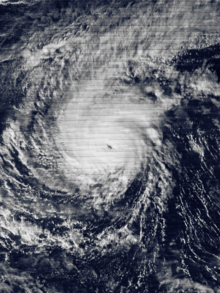 Alice near peak intensity on January 7, 1979 | |
| Meteorological history | |
|---|---|
| Formed | December 31, 1978 |
| Dissipated | January 15, 1979 |
| Very strong typhoon | |
| 10-minute sustained (JMA) | |
| Highest winds | 175 km/h (110 mph) |
| Lowest pressure | 930 hPa (mbar); 27.46 inHg |
| Category 3-equivalent typhoon | |
| 1-minute sustained (SSHWS/JTWC) | |
| Highest winds | 205 km/h (125 mph) |
| Overall effects | |
| Fatalities | None |
| Damage | ≤ $500,000 (1979 USD) |
| Areas affected | Marshall Islands, Guam |
| IBTrACS | |
Part of the 1979 Pacific typhoon season | |
Typhoon Alice was an unusual West Pacific tropical cyclone that caused extensive damage in the Marshall Islands in January 1979. The first tropical cyclone and the first typhoon of the 1979 Pacific typhoon season, Alice formed on December 31, 1978 from a tropical disturbance at both an atypically low latitude near the equator and during a time of year climatologically unfavorable for tropical cyclogenesis. The system strengthened as it tracked northwest, reaching tropical storm strength on January 1, 1979. Alice then began to move erratically through the Marshall Islands, causing heavy rainfall and gusty winds that destroyed crops throughout the archipelago. Significant damage occurred in Majuro and Enewetak Atoll, where gusts of 80 mph (130 km/h) were reported and one person was injured. Nuclear cleanup operations on Enewetak in the wake of postwar nuclear tests there were disrupted, with repair of cleanup facilities lasting several months. The damage toll was estimated at between US$50,000–$500,000.
After January 6, Alice strengthened into a typhoon and took a westward course, strengthening to its peak intensity with winds of 125 mph (205 km/h) two days later. A weakening trend began thereafter as the storm tracked south of Guam on January 10, prompting thousands to evacuate to shelters though ultimately causing minor damage. After passing the island Typhoon Alice reintensified to a secondary peak intensity before strong wind shear induced rapid weakening, resulting in the storm's dissipation on January 15.